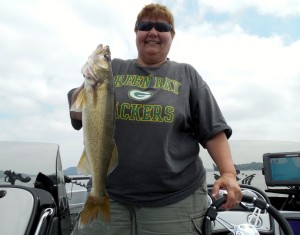By some twist of fate, the bite for walleyes and saugers has not improved very much yet this fall. There have been some ”ok” days, but not a lot of consistency as we wait for water temps to cool, stabilize, and concentrate the fish in predictable areas. Standard tactics such as trolling crank baits and jigging have been inconsistent at best, but one technique that has been producing some fish is the old tried and true Lindy Rig. This really is a simple way to methodically work an area and entice walleyes and saugers to bite when the going gets tough. There are just a few components to the rig though variations will allow for greater opportunities. To rig up, do the following: thread a walking sinker on the main line to the rod, then tie on a barrel swivel. Next tie a 3’ leader of 8lb test monofilament from the barrel swivel to a size 4 or 6 octopus hook. The hook should be snelled for best hooking percentage. Options for the rig include adding a colored bead or float on the snell above the hook, or a floating jig head in place of the hook. If you use minnows, go with a size 4 octopus hook. If you use leeches or crawlers, use a size 6 hooked right through the sucker on the tail of the leech, or once through the nose of the crawler. A small bubble of air injected into the tail of the crawler will help to float it. The size of the weight will depend on the depth your fishing and the speed your boat is moving. For depths of 10’ or less, use a ¼ oz. walking sinker. For depths from 10’-15’ try a 3/8 oz. walking sinker. For depths from 15’-20’ use a ½ oz. or a ¾ oz. walking sinker. The weight required will vary depending on how fast the wind, current or your motor moves you along. 
How to fish a Lindy rig:
Using spinning tackle, open the bail and drop the bait to the bottom. Leaving the bail open, keep the line on your finger as you move the boat with the electric motor or allow the wind or current to drift the boat along the structure your fishing. This is typically a slow presentation, and I like to crawl along at 0.5 to 1 mph using enough weight to keep my line at around a 60° angle. In water less than 10’ deep, increase this angle to keep the bait farther back behind the boat as the boat can spook fish. When you do feel a bite, drop the line off your finger and immediately strip off several feet of line so the fish does not feel any resistance. Count from 1 Mississippi to ten Mississippi, and close your bail. Slowly reel in your slack, and if you feel the weight of the fish, set the hook! If you miss the fish, next time count from 1 to 15 or 1 to 20 to give the fish time to chew its way up the bait. The whole point of the open bail and the walking sinker is to allow these neutral to negative fish adequate time to take the bait fully in their mouth without feeling any resistance as the line flows off the reel and through the sinker. If they are aggressively hitting the bait, then another faster paced presentation is likely to work also, and allow you to cover water more efficiently.
Additional options to try with bait are tail hooking your minnows so that they struggle more, or hooking the crawler once through the middle in order to give it a “U” shaped “wacky worm” profile popular in bass fishing. Hooking the worm through the middle gives it a shorter profile and can help with short strikes. The Lindy Rig has been in use for around 50 years and has accounted for countless walleyes caught. Isn’t it time you rediscovered this old favorite?
Tight lines,
Gary Sanders
Lake Wisconsin Walleyes, LLC

